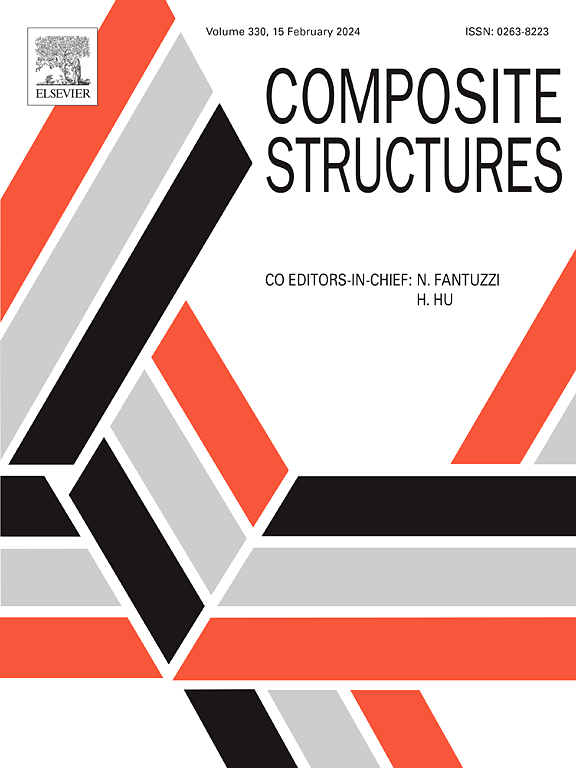CFRP/AL复合材料螺纹接头的优化及力学性能研究
IF 6.3
2区 材料科学
Q1 MATERIALS SCIENCE, COMPOSITES
引用次数: 0
摘要
为了提高螺纹连接的强度,在碳纤维金属层压复合材料表面制备了内螺纹连接、内螺纹连接和粘接螺纹连接三种螺纹连接方式。研究了叠层顺序和接缝类型对复合材料拉伸性能和破坏行为的影响。对不同叠层顺序和螺纹连接方式的CFM试件进行了拉伸试验。此外,采用数字图像相关(DIC)技术实时捕捉拉伸变形过程。结果表明:当接头的叠层顺序为Al-CFRP时,同类型螺纹接头的承载能力显著高于CFRP-Al顺序,分别提高9.5%、9.0%和12.1%;此外,在Al-CFRP叠层顺序下,改进的粘接螺纹接头的极限承载力为11.05 kN,比内螺纹接头和内螺纹接头分别提高了38.3%和18.8%。此外,随着螺杆倾角的增大,试件的破坏模式由挤压破坏转变为挤压-剪切复合破坏,试件表面的损伤程度逐渐加重。极限荷载下的应变分布和面外位移证实了上述破坏模式。该研究为CFM螺纹接头的优化设计提供了重要的参考。本文章由计算机程序翻译,如有差异,请以英文原文为准。
The optimization and mechanical performance of threaded joints in CFRP/AL laminated composites
To enhance the strength of screwed connections, three types of threaded joints—internal threaded joints, insert threaded joints, and adhesively bonded insert threaded joints—were fabricated on the surface of carbon fiber metal laminate (CFM) composites. The study investigates the influence of laminate stacking sequence and joint type on the tensile properties and failure behavior of the composites. Tensile tests were conducted on CFM specimens with different laminate stacking sequences and threaded joint types. Additionally, the digital image correlation (DIC) technique was employed to capture the tensile deformation process in real time. The results indicate that when the laminate stacking sequence of the joint is Al-CFRP, the load-bearing capacity of the same type of threaded joint is significantly higher compared to the CFRP-Al sequence, with improvements of 9.5 %, 9.0 %, and 12.1 %. In addition, under the Al-CFRP stacking sequence, the ultimate load-bearing capacity of the improved adhesively bonded insert threaded joint was 11.05 kN, which represents an increase of 38.3 % and 18.8 % compared to the internal threaded joint and the insert threaded joint. Additionally, as the screw inclination angle increases, the failure mode of the specimen transitions from extrusion failure to a combination of extrusion and shear-out failure, with the surface of the specimen progressively exhibiting more severe damage. The strain distribution and out-of-plane displacement at the ultimate load confirmed the aforementioned failure modes. This study provides important insights for the optimization design of CFM threaded joints.
求助全文
通过发布文献求助,成功后即可免费获取论文全文。
去求助
来源期刊

Composite Structures
工程技术-材料科学:复合
CiteScore
12.00
自引率
12.70%
发文量
1246
审稿时长
78 days
期刊介绍:
The past few decades have seen outstanding advances in the use of composite materials in structural applications. There can be little doubt that, within engineering circles, composites have revolutionised traditional design concepts and made possible an unparalleled range of new and exciting possibilities as viable materials for construction. Composite Structures, an International Journal, disseminates knowledge between users, manufacturers, designers and researchers involved in structures or structural components manufactured using composite materials.
The journal publishes papers which contribute to knowledge in the use of composite materials in engineering structures. Papers deal with design, research and development studies, experimental investigations, theoretical analysis and fabrication techniques relevant to the application of composites in load-bearing components for assemblies, ranging from individual components such as plates and shells to complete composite structures.
 求助内容:
求助内容: 应助结果提醒方式:
应助结果提醒方式:


